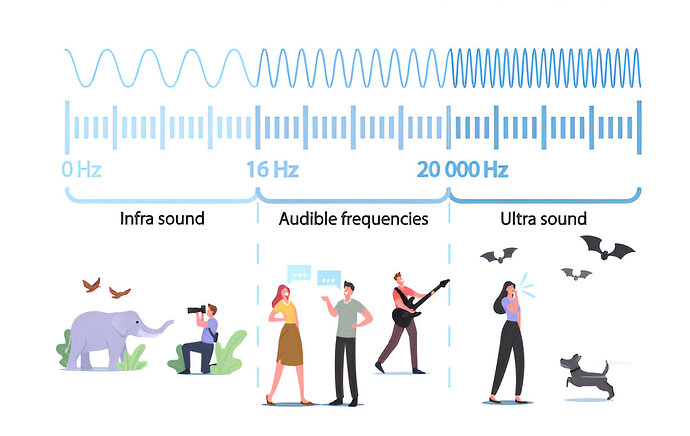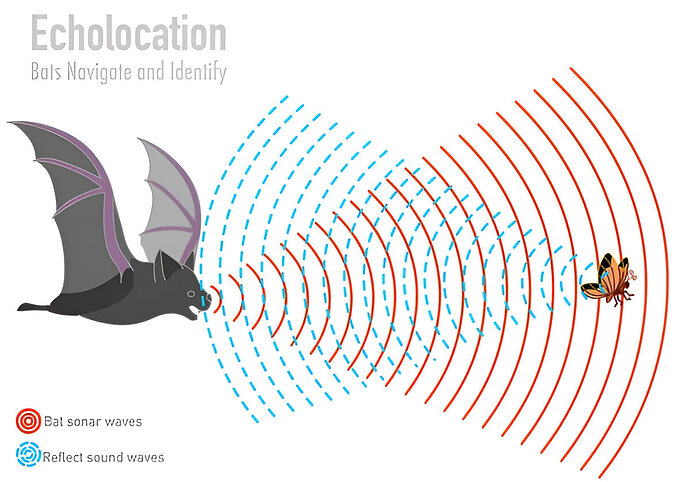In yesterday’s Chatshaala @Akhil discussed about conservation of Bats as a part of his research, also we came across different frequencies that humans can hear as well as bats have external ear with sharp hearing in which it can be heard though dense forests. For context :
Sound is all around us — in the roar of thunder, the beat of a drum, the chirp of a bird, or the ultrasonic calls of a bat. But how often do we pause to consider the frequencies behind these sounds?
Let’s explore examples of real-world sounds across the frequency spectrum and how animals like bats harness high-frequency sound for survival.
![]() Human Audible Frequency Range: 20 Hz to 20,000 Hz
Human Audible Frequency Range: 20 Hz to 20,000 Hz
![]() Low Frequencies (20 Hz – 100 Hz)
Low Frequencies (20 Hz – 100 Hz)
These are deep, rumbly sounds often felt as much as heard.
20 Hz
-
Subwoofer rumble in action films
-
Distant thunder
-
Seismic vibrations
-
Elephant infrasound communication
-
Volcano monitoring infrasound
30 Hz
-
Large truck engine idling
-
Bass in hip-hop tracks
-
Low-frequency earthquakes
-
Wind turbine blade resonance
40 Hz
-
Bass drum hit
-
Fading thunderclap
-
Whale communication
50 Hz
-
Air conditioner or fan vibrations
-
MRI machine thumps
![]() Mid-Low Frequencies (100 Hz – 500 Hz)
Mid-Low Frequencies (100 Hz – 500 Hz)
100 Hz
-
Deep male voice
-
Humming air conditioner
-
Motorcycle engine
-
Heartbeat on medical monitor
200 Hz
-
Vacuum cleaner hum
-
Door thump
500 Hz
-
Low-pitch cough or sneeze
-
“Ah” vowel sound
-
Background stadium roar
![]() Mid Frequencies (1000 Hz – 5000 Hz)
Mid Frequencies (1000 Hz – 5000 Hz)
1000 Hz (1 kHz)
-
Phone dial tone
-
Timer or alarm clock beeps
-
Mid-range female speech
-
Flute note
-
School bell
2000 Hz
-
Consonant sounds like “S,” “T,” and “K”
-
Whistling
-
Toddler’s shout
3000 Hz
-
Dog bark (high component)
-
Sparrow singing
-
Click pen snap
4000 Hz
-
Oil sizzling
-
Car alarm chirp
-
Parrot screech
-
Child screaming
5000 Hz
- Sharp human whistle
![]() High Frequencies (10,000 Hz and above)
High Frequencies (10,000 Hz and above)
10,000 Hz
- Chalk squeak on board – uncomfortable yet unforgettable!
![]() Beyond Human Hearing: The World of Bat Echolocation
Beyond Human Hearing: The World of Bat Echolocation
Bats operate in an ultrasonic realm, far above human hearing. Their echolocation frequencies are finely tuned to match their environment and prey.
![]() Examples of Bat Echolocation Frequencies:
Examples of Bat Echolocation Frequencies:
![]() Rufous Horseshoe Bat: 70 – 85 kHz
Rufous Horseshoe Bat: 70 – 85 kHz
![]() Indian Pipistrelle: 40 – 50 kHz
Indian Pipistrelle: 40 – 50 kHz
![]() Schneider’s Leaf-Nosed Bat: 98 – 110 kHz
Schneider’s Leaf-Nosed Bat: 98 – 110 kHz
![]() Hipposideros lankadiva: 75 – 95 kHz
Hipposideros lankadiva: 75 – 95 kHz
![]() Why So High? Adaptations Explained
Why So High? Adaptations Explained
Dense, cluttered habitats (like forests or caves):
Bats use high-frequency calls (90–120 kHz) to navigate around leaves, branches, or walls. The shorter wavelengths reflect off small obstacles, giving better resolution.
Prey type matters:
-
Insectivorous bats hunting tiny moths or midges:
Need very high frequencies (~100–120 kHz) for precision targeting. -
Bats hunting larger insects (like beetles):
Can rely on lower frequencies (~30–60 kHz) because the prey reflects stronger echoes.
![]() Conclusion
Conclusion
From the low-frequency rumble of thunder to the ultrasonic clicks of bats navigating the night sky, sound frequency is a powerful force — shaping both human experiences and animal behaviors. Understanding frequencies isn’t just for scientists or musicians; it’s a gateway to perceiving the hidden rhythms of our world.
![]() Reference
Reference

